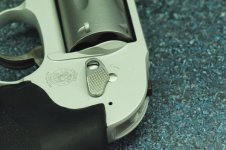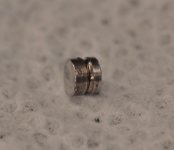Hopefully helpful...
I posted this on another forum:
Okay, guys, here you go:
I assumed that everyone already knows how to pop the sideplate, so hopefully, the pics will be adequate. I realized today that there was one I should have taken, and didn't, but I'm not going to strip it down to shoot one photo.
Here's the original, ugly-ass lock:
Here's the internal view, with all components of the lock assembly in place:
Here, the "flag," along with its tiny spring, have been lifted out, the lock cylinder/cam assembly has been removed, and you see the lock plug lying on top of the lock hole, just so you can see what the plug looks like. (I intended to shoot one of the assembly with just the flag and its tiny spring removed, but forgot.):
Here's the plug, from the inside, held in place by the same fork that held the lock cylinder/cam:
Now, here's the outside, looking much better, I think:
Overall, I just like my gun better now:
Removal of the lock cylinder/cam is the only tricky part. The fork must be firmly held back against its little blue spring, to full compression, while the lock cylinder is plucked out with a dental pick or pushed out from the outside. I had to put the revolver in my vise to have the necessary third hand. I used a tiny punch, on which I'd shaped the end to a chisel for some long-forgotten task, to depress the fork and spring. Insertion of the plug was easier, and can be done from either outside or inside. From the outside is easier, aligning the flat with the fork, so a little less compression of the spring is necessary.
The flat on the plug eases assembly, and John Whitt advises me that it also is a place to rest the flag, if one chooses to leave it in. Other than just having it there to fill the slot in the frame, I don't know why one would want to do that.
Hope this helps.










